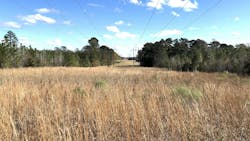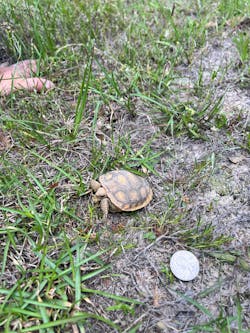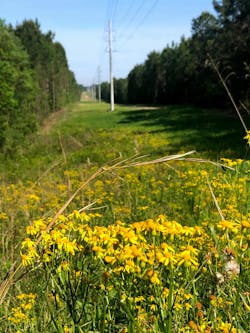Preserving Endangered Species: The Gopher Tortoise and Cooperative Energy's Approach
Listen to a Narrated Version of This Story in the ICYMI Series for the Line Life Podcast
Wes Graham holds up his hand like a sergeant halting his squad. “See him? There he is,” he said. The right-of-way (ROW) manager with Cooperative Energy, Hattiesburg, Mississippi, points toward a half-moon-shaped hole in the ground about 15 ft away. A flash of a figure just disappeared into the burrow. It’s unseasonably warm, and the gopher tortoises are active, “doing maintenance,” as he said, on their underground burrows.
“In the spring, the females will lay their eggs on the apron of that burrow,” said Brad Morris, ROW specialist, Cooperative Energy. “They’ll start to hatch in September or October, and from the moment they hatch, they’re on their own. They’ll start to dig almost immediately. It’s an incredible thing to see.”
That the gopher tortoise is here is no surprise at all; where Graham and his visitors are standing is at the edge of, but still well within, its native territory. But the fact that gopher tortoise numbers have increased — dramatically — in the years since Cooperative Energy established its current vegetation management (VM) protocol, and the level to which they’ve increased? Even Graham and Morris are shocked.
If You Build It …
Once you get past the idea of a burrowing tortoise, it’s hard to imagine many other animals better suited to a life lived mostly underground. Scaled front feet and powerful back feet give the gopher tortoise both the leverage and the tools necessary for building the burrows that average 15 ft to 20 ft in length. Most of the water they need for survival comes from their diet—mainly grasses, young shoots and stems, certain flowers and the occasional berry or mushroom.
From a regulatory perspective, the gopher tortoise enjoys something of a complex status. The western populations, which include Mississippi’s, are listed as “threatened” under the U.S. Endangered Species Act; state-level listings vary from “endangered” to “protected.” The threats faced by the gopher tortoise are, for the most part, the same as those faced by most other non-human species: fragmentation or outright destruction of habitat; predation by native and invasive species; changing weather patterns and declining genetic diversity. Mississippi’s gopher tortoise population has been noted for its “low recruitment”—that is, the birth and the survival rates of hatchlings can’t keep up with adult mortality rates.
Yet despite its vulnerability, the gopher tortoise is considered a keystone species; its burrows — both active and abandoned — serve as homes for up to 350 other species of animals. Their diet and feeding patterns help spread seeds, contributing to the preservation of the ecosystem in which they live.
And while few animals have enjoyed the protection of such committed guardians as Graham, he insists that neither he nor Cooperative Energy has ever intended to be caretaker to an endangered species.
“It was by accident that we got into the gopher tortoise management business,” he said. “We’re not doing anything but managing the vegetation to maintain reliability and create a safe working environment for our crews.”
In the process of creating that safe environment, however, something else happened. “It’s just like the line from the movie,” Graham said. “‘If you build it, they will come.’”
A Post-Katrina VM Reckoning
Cooperative Energy’s current VM program was put into place in 2008, shortly after Graham started and just three years after Hurricane Katrina cut its devastating path across the southeastern United States. For Cooperative Energy, the storm cleanup was a time-consuming, labor-intensive, but ultimately eye-opening, exercise.
“Katrina showed us we had a problem,” Graham said. “All of our lines were affected to some degree. So, in 2007, once we’d finally cleared all the debris from our rights-of-way, we decided to refocus on vegetation management.”
Working with a team of advisers from the U.S. Fish and Wildlife Service (USFWS), the U.S. Forest Service (USFS) and outside conservation groups, Graham developed a program that, for the first time in Cooperative Energy’s history, integrated herbicides into the overall VM toolkit. But as carefully as the program was planned, it had to be even more carefully executed.
“If you don’t have a herbicide program already, you can’t stop mowing cold turkey,” Morris says. “Mississippi, especially southern Mississippi, is almost subtropical. We have plants that don’t go into true dormancy, so if you go three years without mowing or applying herbicides, you’ve lost it. You’re back to square one.”
Graham remembers the early meetings with Cooperative Energy’s senior leadership — meetings in which he, as a relatively new employee, had to ask for a significant increase to the VM budget. He credits those managers with having the foresight to understand and accept that changes needed to be made and with the trust they placed in him and his plan.
“We had to almost double our vegetation management budget,” Graham said “So, there was some hesitation on the part of our management and executive leadership. But when I laid out what we wanted to achieve and how we wanted to do it, they were open to it. We wanted to mow, then follow up the next year with an herbicide treatment. That first year, we did about 4,000 acres; the following year, it was 12,000. Now, we’re spraying half our system every year.”
By any standard of measurement, the program is working. Cooperative Energy’s ROWs are carpeted in native grasses and wildflowers. Application rates have steadily dropped from 20 gallons per acre (GPA) to 3 GPA, all by low-volume backpack spraying. Spraying costs are less than $75 per acre, while per-acre mowing and side-trimming costs are well over $1,000. Utilities like Duke Energy and Tennessee Valley Authority have come to Hattiesburg, Mississippi, to learn more about Cooperative Energy’s integrated vegetation management (IVM) program.
And then, there are the gopher tortoises.
Increasing the Habitats
“This is a special place,” Graham tells his visitors. “This is one of the first places we had gopher tortoises that I knew of, and they have just thrived as we’ve introduced IVM principles.”
The group is standing in the shadows of Cooperative Energy’s Plant Morrow generating station, just outside Hattiesburg, Mississippi. As many as 30 active burrows are within sight here, in what Graham calls the “gopher tortoise resort.” Each burrow, whether it’s active or abandoned, is marked with a yellow guy-wire protector. Graham tells the story of how he and Cooperative Energy came to understand the cause-and-effect relationship between their VM efforts and the presence of the tortoise.
Just a couple of years into their herbicide program, Graham was scouting on USFS land, preparing to change out damaged utility poles. While performing an endangered species survey, he noticed and marked a handful of burrows; no more than three or four, he said. He delivered his report to the USFS and was cleared to do the pole change-outs.
Two years later, after Cooperative Energy had established its herbicide program, Graham was doing a similar survey on adjacent land.
“So, while I was there,” he said, “I went through the area we were in two years prior. I wasn’t paying much attention, just marking the burrows I found. When I got back to the office and dumped the data, I said, ‘Wow, we’ve got a few more burrows out there.’ During this time, thanks to our herbicide program, we were also seeing the transition from rank woody vegetation to native grasses and low-growing shrubs on our rights-of-way. So, the very next year, on another line, I went and did the same thing. And I noticed immediately the presence of gopher tortoises had increased.”
Graham, anxious to have confirmation of what we saw in the field, gathered his maps and waypoints and sent them to a colleague at Mississippi State University in Starkville for analysis.
“He called me back a few days later and said, ‘Yeah, you’ve got something happening. Your gopher tortoise populations are increasing,’” Graham says.
But it wasn’t just that the numbers were going up, although they were — significantly. The tortoises were establishing new burrows off the centerlines, closer to the ROW margins and out of the main path of travel for crews and machinery.
“When I started,” Graham said, “every right-of-way had a use trail or game trail going from structure to structure. That’s what our line crews would use to get down the right-of-way as best they could. But because the tortoises can’t live in tangled, overgrown habitat, that’s also where the gopher tortoises were digging their burrows — on or close to these game trails. Once we started spraying and opening up these rights-of-way, we saw populations increase; but we also saw burrows being moved off the centerlines.”
Even now, years after the fact, Graham shakes his head at the simple but profound realization.
“Through the use of herbicides, we’d created habitat for an endangered species,” Graham said.
Doing the Right Thing
Today, Cooperative Energy’s program is a model of integrated vegetation and habitat management. Utility vegetation management and conservation organizations from across the South and Southeast come to see the results for themselves, to learn and to offer their own knowledge.
“Once we started seeing the population increases, I wanted our crews to get some formal training on working around the gopher tortoise,” Graham said. “So, we brought in an expert from Florida to see what we were doing and what more we should be doing.”
As a result, Graham and Morris worked with the USFWS field office in Jackson, Mississippi, to develop an annual certification program for Cooperative Energy’s crews and contractors. Each participant receives a hard-hat decal indicating they’ve completed the training.
And while Graham insists that helping preserve an endangered species was never the goal of his program, he, Morris and Cooperative Energy take seriously the role they’ve inherited.
“Our job is to make way for our crews to go out on a Saturday night after a thunderstorm and get power back on,” Graham said. “So, operationally, the presence of the gopher tortoise does cause some challenges. But from a conservation standpoint, anything we can do to help a threatened species and still provide electric service to our customers—to me, that’s what we’re supposed to be doing. It just proves what I tell people all the time: if you’re doing the right thing, everything else will fall into place.”
About the Authors
Editor's note: This article was authored by Logan Martin, a VM specialist for Corteva Agriscience. Wes Graham, ROW manager for Cooperative Energy, and Brad Morris, an ROW specialist for Cooperative Energy, also contributed to this story.
About the Author
Logan Martin
Logan Martin is a territory manager for the land management business of Corteva Agriscience. In his role, he works with utilities to develop vegetation management programs throughout Alabama, Mississippi and the Florida panhandle. Martin received his bachelor’s degree in agronomy from Missouri State University and his master’s degree in agronomic weed science from the University of Florida.



